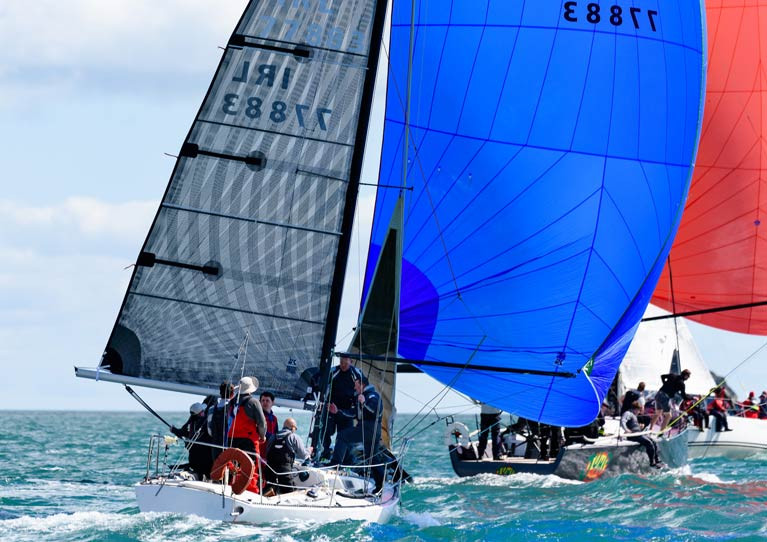Cork Harbour sailors Mel and Kieran Collins from Crosshaven describe how they transformed Coracle VI, their vintage Olson 30, into an 'IRC weapon'
Prior to buying the boat, we did extensive research on which boat to buy and why. The Olson 30 designed by George Olson of Santa Cruz, CA, around 1978 was built around the same time as the Half Tonners; but the boat was a strict one-design class in the U.S. and was a predecessor of the sports boats that came 15 years later. For its day, the Olson 30 is a highly unusual boat in that it planes downwind in about 20 knots. To put it another way, it needs about two knots more wind to plane than a 20-year newer design like the 1720. Loads of useful background info on the Olsson can be found here
Going in, we wanted a boat that was both enjoyable to sail and competitive for club racing. It turned out better than we hoped. Working out whether it would be competitive in IRC rating, however, was the difficult thing.
A few Olsson 30s had raced IRC in the states, but IRC just really is not the dominant rating rule there. So, while we had an idea what the handicap would be with the 155% overlapping genoa, we did not know how competitive that would be on IRC here. The only thing we could do was use a spreadsheet to convert PHRF handicaps to IRC and compare boats that we know raced in Europe, too. The J/109 and J/24 were the most obvious contenders, but there were a few others. We also had access to quite a few good ORC handicap calculations and the Olson 30 compared favourably to boats we knew.
 Coracle VI under spinnaker Photo: Bob Bateman
Coracle VI under spinnaker Photo: Bob Bateman
After buying the boat, we started off trying out the 155% #1 genoa, the 130% #2 genoa, and 100% #3 headsail. The feeling was the 155% needed eight crew and really had the boat overpowered over 10 knots. It was also quite difficult to handle a bigger crew as the cockpit in the Olson is quite small. The Olson was designed as an offshore boat.
With that information, we contacted UK Sailmakers Ireland about a large new spinnaker so that we might be able to plane a bit earlier and an overlapping genoa, 140% genoa designed to fit the to the max area.
This proved a competitive setup for the Olson 30. We were unbeatable if we got over 20 knots of breeze in planning conditions with the genoa and larger kite.
In light conditions, we could keep up with, and race very closely with the Half Tonners, if not quite beat them; we could beat pretty much most other boats in these conditions in our class as well.
Getting the design of the sails and area right took a fair bit of thought and design. We were lucky enough to work with UK Sailmakers Ireland who were able to 3D model the sail design so we could see what we were getting before we ordered. As such, we knew we were going in the right direction.
 Ideal conditions for the Olson 30 in Cork Harbour
Ideal conditions for the Olson 30 in Cork Harbour
Breezes of 10-15 knots is about ideal condition against most boats except Half Tonners; we were fast downwind and get the most out of the 140% overlapping genoa upwind. Still, we only start to beat the Half Tonners over 12 knots. Unfortunately, at 13 knots the larger boats, like a J/109, would come into their own and we would struggle. Regardless, this left us in a good position in that if we got mixed conditions, we would be competitive.
There really was no weakness, but to be sure of a win we needed 20 knots plus, which is rare in our racing area. We were not happy to just leave it at that. We looked at a few other enhancements at his point: an asymmetric spinnaker and adding weight to the boat (as it is exceptionally light – 1,600 kg) Neither made any real difference to the IRC rating on trial certs.
In 2020, we decided to look to optimize the boat further. We focused on optimising the sail plan and the hull displacement, we looked at reducing the spinnaker area a little as we felt we didn't get the benefits in light air from the very large spinnaker unless we were reaching. Dead downwind it was hard to fly. While a real weapon in the 10-20 knots wind range, we felt the larger chute did not help much under 10 knots.
 A 100% non-overlapping headsail
A 100% non-overlapping headsail
The second thing we did was move to a 100% non-overlapping headsail. We worked with UK Sailmakers to design a headsail that would fit the foretriangle to the max plus a new, slightly smaller optimised S2 symmetrical spinnaker. The sails were designed in 3D, so it fit the rig perfectly with the max area. We worked out the headsail area from that and ran a trial cert.
By moving from a 140 % to a 100 % headsail and the smaller spinnaker, we received a 12-point drop in our rating.
Our feeling was that, in light air under 10 knots, we may still struggle with Half Tonners, but we should be still competitive against all other boats. We do not expect much difference from the smaller optimised spinnaker but would expect to see some drop-off upwind in the lighter air. A change of 12-points is a big gain rating wise, so we will have to see how it all works out.
 By moving from a 140 % to a 100 % headsail and the smaller spinnaker, we received a 12-point drop in our rating
By moving from a 140 % to a 100 % headsail and the smaller spinnaker, we received a 12-point drop in our rating
In 10-20 knots. we still should go quite well if a little slower than before, but the 12-point handicap difference should easily make up for this. It also allows us to sail with one or two fewer crew; the boat is generally pretty cramped anyway.
We will now rate close to Half Tonners so should still be competitive against them and, as the wind goes up to 10 to 20 knots, we should be much more competitive against the big boats like J/109 also.
Really, the big risk is in sub 10 knots but over 10 we believe it will be a net gain. Onboard Coracle VI in light airs
Onboard Coracle VI in light airs




























































